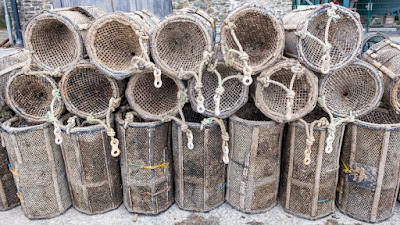Baskets are a vital survival commodity that will be necessary during an SHTF situation. One of their uses is to catch, carry, and store fish in the seas. When you get lost in an island or are living in a post-apocalypse world, having a fish basket trap will make your survival experience more convenient.
Read on to learn more about how to create a fish basket trap!
Basketry Terminology
Here are some terms in basketry you need to remember:
- Spokes. These are the foundation of a round or oval basket. In a square or rectangular basket, these are known as stakes
- Base. This is the bottom of the basket
- Packing. This is the term used for pushing the weavers tightly together.
- Weaver. This is the individual horizontal rods woven together into the sides of the basket
- Splicing. When you add additional weavers to the basket because the previous one has grown too short, you are splicing.
- Shaping. This is done when you use your weaver to splay out or pull together the spokes or stakes of a basket under construction.
Why Build a Fish Trap?
Primitive survival in the seas usually requires a fish basket trap since hooks aren’t always readily available. A basket trap lets you fish 24 hours a day while also doing other activities. With a basket, all you have to do is check it a few times a day, repair occasionally, and add more bait when needed. Plus, it’s a one-time calorie and time expenditure!
With a fish basket trap, you, as a lone survivor, can have more time doing other work like building a shelter, purifying water, and gathering some firewood.
Another great reason to build any style of live trap is that live food doesn’t spoil! A fish caught in the basket can be kept alive for an extended amount of time, making the basket a storage tool. Even though it will take some time to construct a basket, it will surely outlast your survival ordeal.
How to Make a Fish Basket Trap
The first step is to choose how big your trap would be. You can decide on this by simply determining the size of the fish you’re catching. The basket usually measures three feet in length in order to catch a small panfish.
Then, cut an odd number of strong green sapling poles that are about ¾ of an inch in diameters. An odd number is important for the over/under weaving technique to work properly. Push your poles to the ground so they touch the bottom. This will ensure that the basket trap is closed on the back end to prevent the fish from escaping. The tops of the sticks can be manipulated inward and outward as you weave to get the desired width in the front of the tarp.
Gathering vines is the most time-consuming part. Go for vines of different sizes. Remember that larger vines mean larger gaps, so it might be hard for you to catch crawfish with them. You can also use greenbrier, cattail leaves, roots, or the small shoots of some trees. Then, begin weaving in an over/under pattern between the poles from the ground up. Make sure to consistently push the woven vines downward, keeping gaps between vines as small as possible.
To create the funnel, place an odd number of sticks in the ground only this time leave a small opening. Weave the funnel in the same over/under pattern all the way to the top before pulling it from the grown and sawing the poles so they are flush with one another.
Learn More:

No comments:
Post a Comment